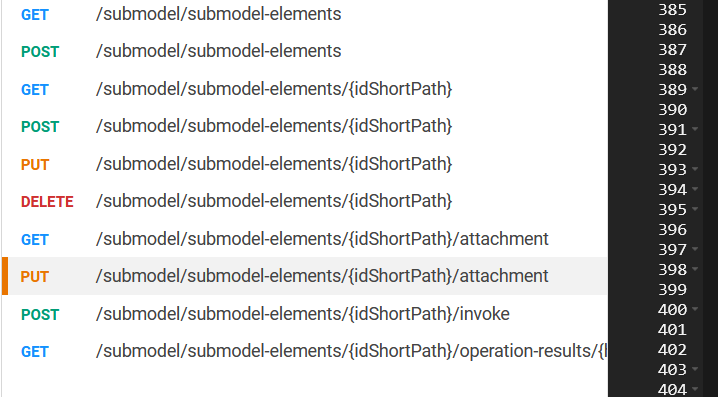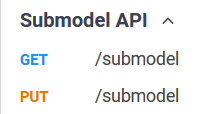This repository contains specifications of the Asset Administration Shell APIs, including in particular the normative OpenAPI files of the AAS HTTP/REST API. These API descriptions are derived from the document series, part 2, "Specification of the Asset Administration Shell - Part 2" published by the IDTA.
This repository provides the OpenAPI files published in the SwaggerHub organization Plattform_i40. All published SwaggerHub APIs are synchronized all the time with the respective folders in this repository using the GitHub Integration feature. In particular, the following APIs are contained:
| API SPEC | GitHub | SwaggerHub |
|---|---|---|
| Entire-API-Collection API | Link | Link |
| Asset Administration Shell Registry Service Specification | Link | Link |
| Asset Administration Shell Repository Service Specification | Link | Link |
| Asset Administration Shell Service Specification | Link | Link |
| Submodel Registry Service Specification | Link | Link |
| Submodel Repository Service Specification | Link | Link |
| Submodel Service Specification | Link | Link |
| Discovery Service Specification API | Link | Link |
| Concept Description Repository Service Specification | Link | Link |
| Aasx-File-Server Service Specification | Link | Link |
The following domains are synchronized manually as domain synchronization is not yet available in SwaggerHub:
| API SPEC | GitHub | SwaggerHub |
|---|---|---|
| Part1-MetaModel-Schemas Domain | Link | Link |
| Part2-API-Schemas Domain | Link | Link |
| DINSPEC16593-Schemas Domain (Deprecated) | Link | Link |
The main branch contains the latest released version of all APIs and Domains. Current and previously released states are tagged with the corresponding release version in this repository, and marked with the Published tag in SwaggerHub.
Working versions may be marked as private in SwaggerHub and therfore may not be visible to the public audience yet. In this repository, working versions appear as branches named after the target release version.
Note: In order to synchronize with the same GitHub branch, all versions should follow the exact same pattern.
The following versioning scheme is applied for release tags: 'V<major>.<minor>.<patch>'. Major versions indicate breaking changes while minor updates are backward compatible. The patch position is increased whenever bugfixes need to be applied. The following release contains the latest version of the AAS schemas (see also the releases section of this repository):
- 3.0.1 is the corresponding release for the
V3.0.1version of the AAS APIs, containing the normative schemas for the published document "Specification of the Asset Administration Shell - Part 2: Application Programming Interfaces - Version 3.0.1". Use this release if you want to work with the latest specified AAS version.
Previous releases (deprecated by 3.0.1):
- 3.0 is the first major release for the AAS APIs, containing the normative API descriptions for the published document "Specification of the Asset Administration Shell - Part 2: Application Programming Interfaces - Version 3.0".
Feature requests, reports about inconsistencies, mistakes etc. are highly welcome! Please submit a new issue.
If you want to contribute, see CONTRIBUTING.md.
SwaggerHub requires a GitHub Access Token with repo permissions. It is good practice that the selected token has a defined expiration date. Therefore, at some point in time when the current token expires, the synchronization will fail and a new token needs to be added through the IDTA repository management team.











